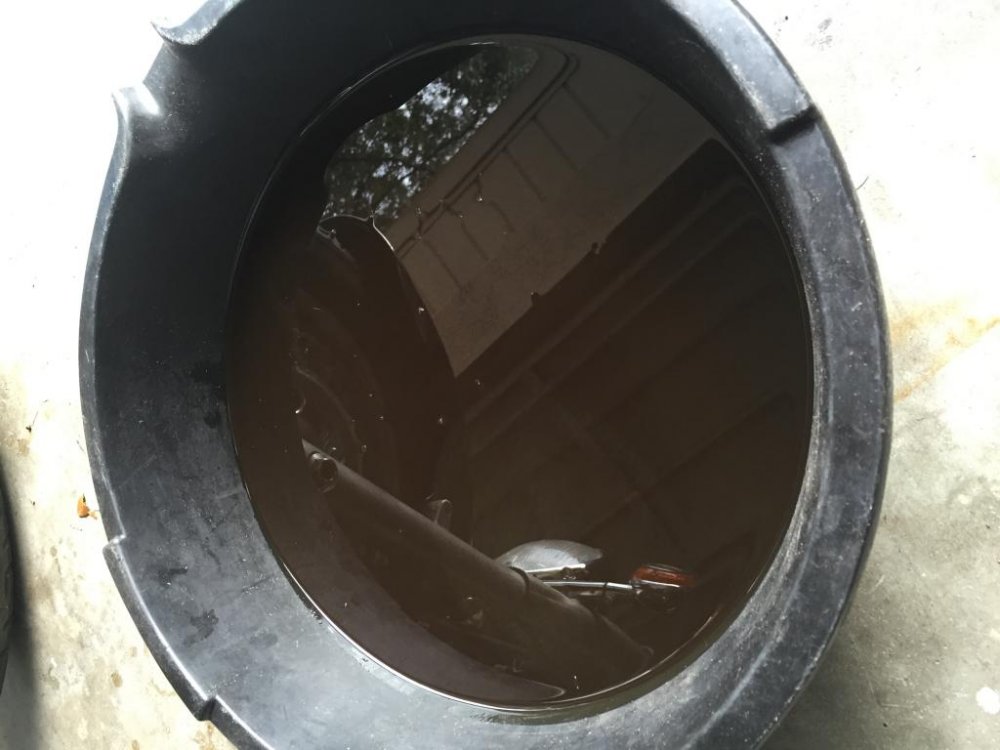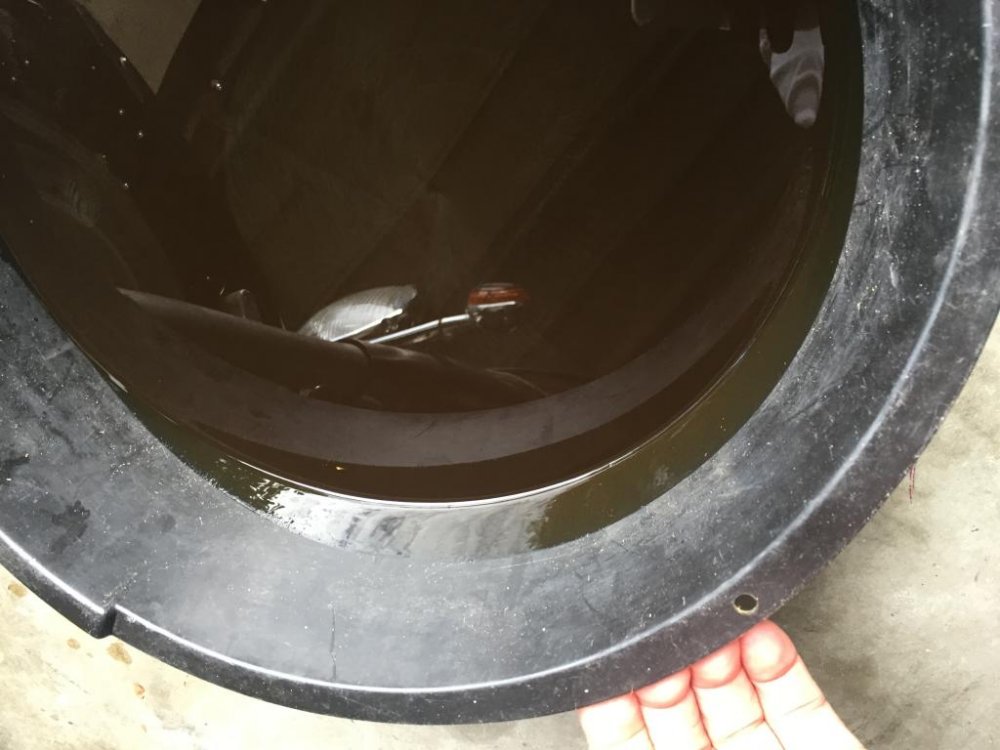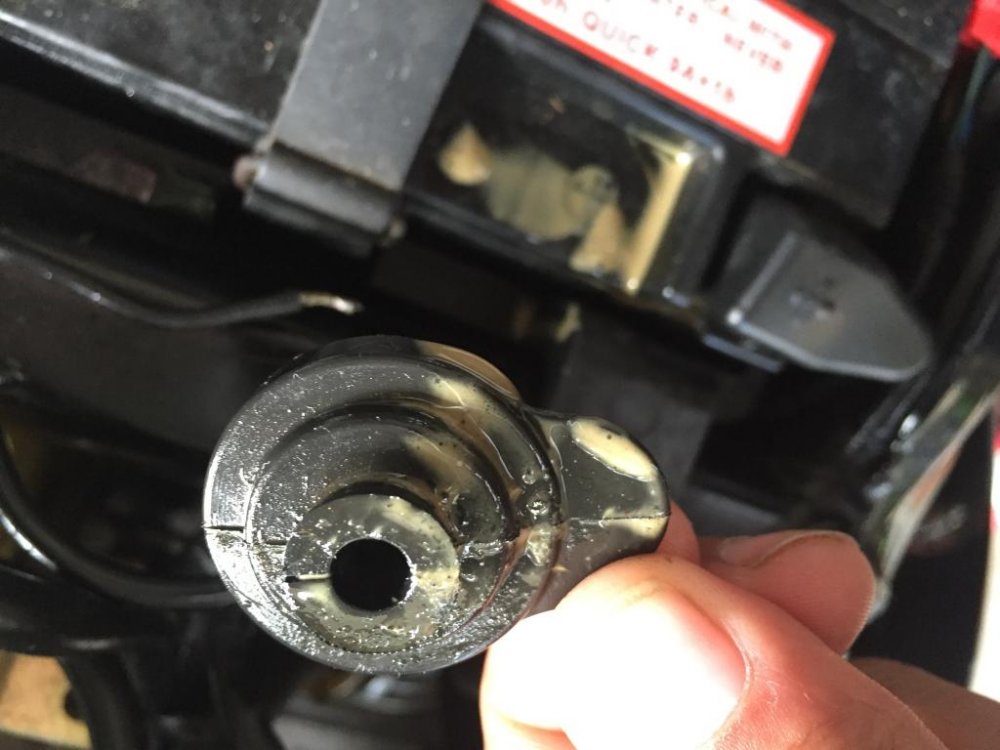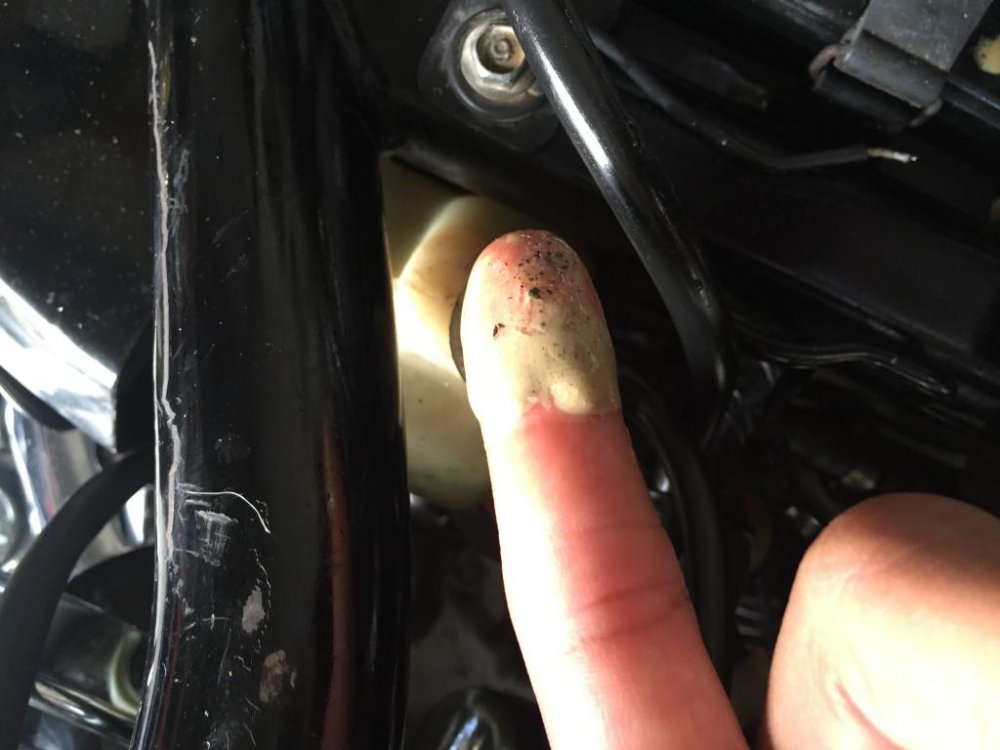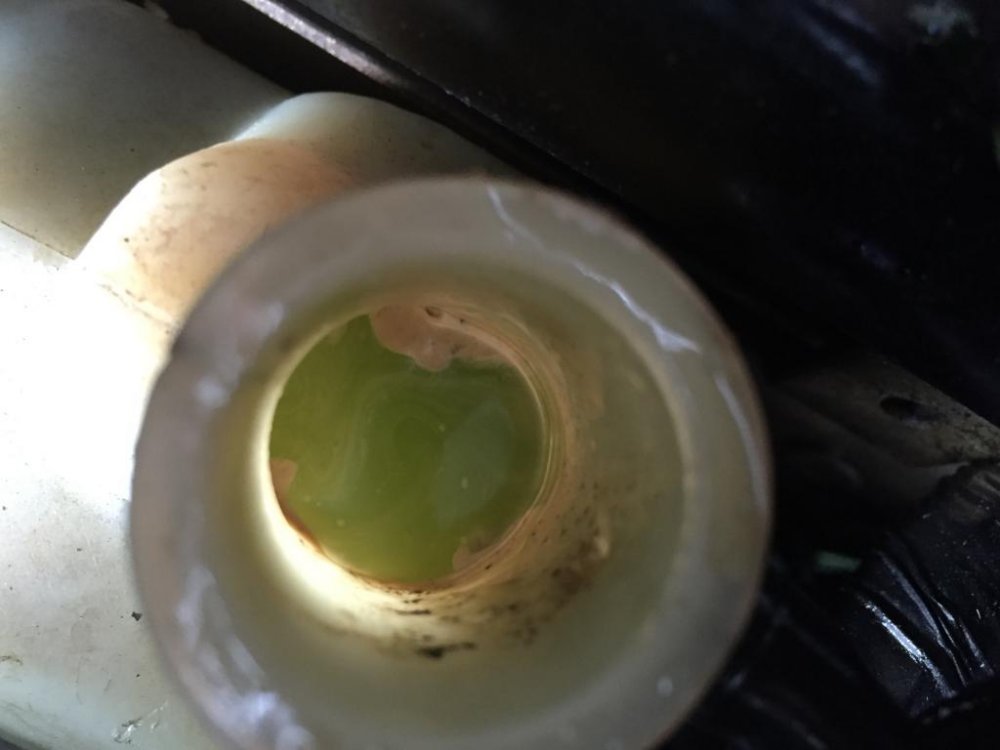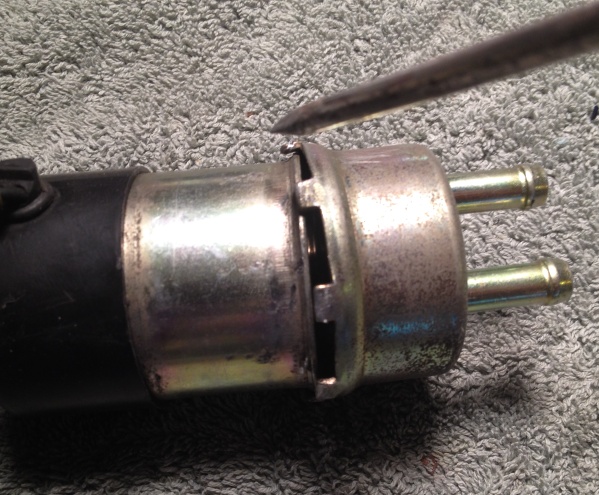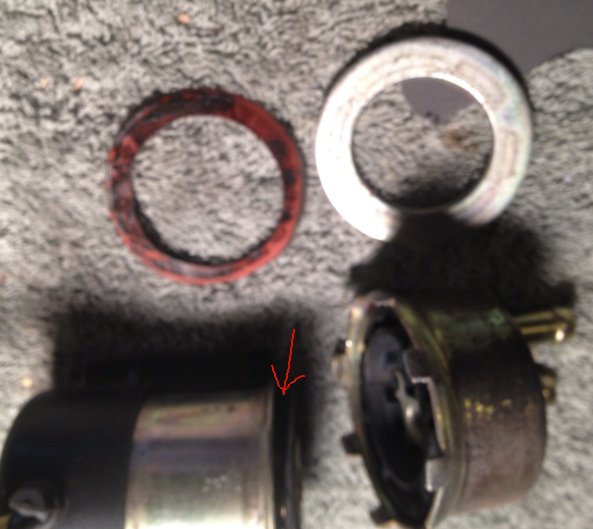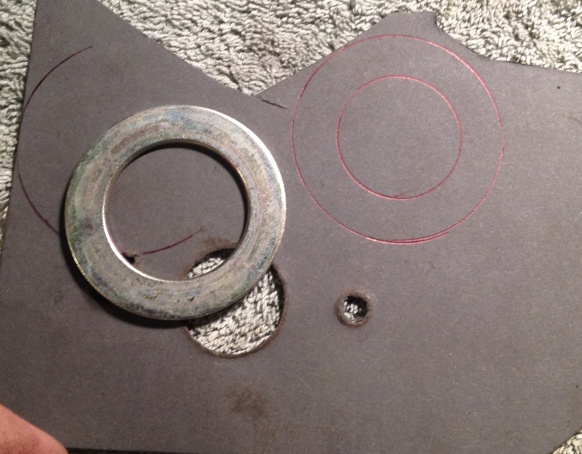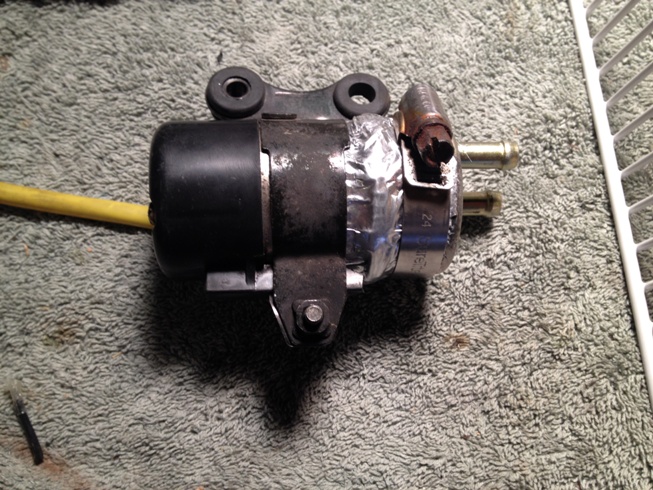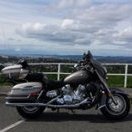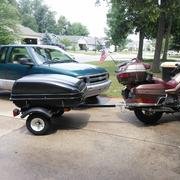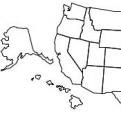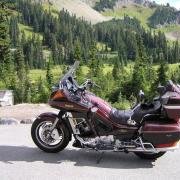Search the Community
Showing results for tags 'gasket'.
-
WARNING - this is LONG, so unless you are actually going to adjust your valves, or just like to read mechanical cookbooks, you probably should just stop here! There is a LOT involved in this job. It needs to be done, but it is probably worth whatever you local shop is charging. I'd certainly pay $200 for it if I trusted the shop, and I'm very comfortable doing the job myself. If you don't trust your shop, or don't have the money, then read on! We periodically have questions and discussions here on valve adjustments, like how often? (26,600 miles), is it really needed? (yes), how to? (read on), etc. And the tech manual, along with several other members, indicate it is a BIG job. So Ponch and I decided to organize a training session to see first-hand what was involved and find out about any surprises before we attempted to help any other members on this. And I want to really emphasize how thankful we are to BuddyRich for his wonderful loan of a shim kit and special tool, along with his selfless help of an entire day of hot sweaty work! Without him, what follows would probably never have happened: Background info: My 2005 RSV had the first valve check/adjustment done on schedule around 27,000 miles through the initial maintenance contract I purchased with the bike. Since the shop did it, I have no idea if any shim changes were actually needed, but since I saw evidence the valve cover gaskets were changed, I will assume that at the end of that service, all 16 valves were within spec. My bike now has 70,000 miles on it, putting it about 15,000 miles overdue for the second valve check. I found about half the valves either right at minimum tolerance or too tight (and three of them were significantly too tight). You get to decide how often you want to do your own bike, but I'll be doing this one by 30,000 miles each time now. Planning: 1. Order your gaskets and find tools and shims first. I wouldn't want to do this job without a valve shim kit unless I was willing to leave the bike torn down for several days to go find the right shims after measuring all the clearances. In addition, there are different ways to hold down the valve buckets to change the shims, but the only "right" way (and certainly the easiest) is to have the special tool; therefore, find or buy one before you start. The valve cover gasket is 4NK-11193-00-00, and the best price I found was at http://www.carolinacycle.com for about $18 ea. We have several members who have the tool and a shim kit (just a selection of various sizes) who may be willing to loan them. BuddyRich and Mother are two you might ask (if anyone else wants their name listed or removed here, please contact me so I can edit this post!). If you find someone to loan a shim kit, PLEASE ask them ahead of time to look at the current collection of shims, particularly the 265 and 270 sizes, to see if any common sizes are in short supply. The shims don't cost much, and in return for the loan, you really should buy at least two new shims in needed sizes before you start the job. Not only will this make it more likely you have the ones you need for your own bike, but it will make the kit better for the next use. It is hard to say ahead of time what sizes might be most needed, since every bike will change the mix. When we did four bikes on the same day, it was very interesting to see that. After the first two bikes, we had a ton of 270 shims, but not many 265 or 275. But after the next bike, there were only a couple 270s left but a big stack of 275. 2. This is a perfect time to change your coolant, so if you need it, have that on hand too. Even if you don't need to change it, you WILL need to drain about a quart, so have an appropriate clean tray and funnel that will allow you to do this and then add it back later. 3. This is also the perfect time to change your plugs, so have them on hand too. 4. Get a can of spray carb and choke cleaner. You are gonna want to pull those carbs (perfect time to set the floats too), and the #1 and #2 carbs are gonna be NASTY with oil residue and dirt. Legend has it that you can do this job without pulling the carbs, but no way I would want to try it. And besides, once you have all the other stuff off, pulling the carbs just isn't that hard. 5. You will really want to have your bike straight up for this job, so a center stand or maintenance jack is good to have on hand. This isn't required, but will be a lot easier and cleaner! On the side stand, you get some oil dumping off the left corner of the heads when you crack the valve cover loose, and more that comes out the covers in the left crank case. The oil mess is much worse if you have Leveling Links and you try this on the side stand! 6. Misc. tools: A good set of feeler gauges are obvious, but you will also need a torque wrench that goes down to 7.2 ft lbs (10 Nm or 86 in lbs), and a magnetic retrieving tool, tweezers or hemostats, and a good quality very small screwdriver (like a mid-size jeweler's driver, but stronger) will be necessary to remove the shims. I also recommend a tube of high temperature RTV 'gasket goo' to use on certain points of the new gaskets. On those feeler gauges, most sets have both inch and mm numbers, but the primary (or even increments) that it uses will be either inch or metric. You will have a much easier time of measuring and selecting shims if you have a metric set. And make certain you have a very bright flashlight - I prefer one of the new small LED ones because of the birghtness and color of the light. 7. Instructions - the shop manual is generally pretty good here, so I suggest you print out pages 3-9 through 3-13. The Job: Start by removing the basic stuff: seat, tank, lower cowlings, air filters. Since you WILL need to drain some coolant, just go ahead and pull those lower cowlings now and make taking off the air filters easier. Remove the "dog bones" connecting the front cylinder heads to the frame. Remove the air intake tract, including the rubber tubes where the air filters attach, the top air plenums, and the rubber T between the air filters (it is held on by one 10mm bolt on the right side of the frame). To get the air plenums off, you will need to first remove the metal straps on top (four screws each), and the two screws holding the crank case vent hose in the middle, then pull the hoses and wire bundles off to the side. After the clamps on top of each carb and the front clamp are loose, each plenum will just pull straight up. When taking off the metal straps, note that the inside front screw on each is longer than the other three, and be CAREFUL when putting all of those screws back at the end of this job - they will strip very easily! When you pull the crankcase breather connection loose from between the two air plenums, be careful of the little foam rings, most of them are stretched and falling apart - unfortunately they don't seem to be available in the parts breakdown. When you lift off each air plenum, there is a vent hose connected on the rear that will just pop off (watch out for the little wire spring clip - they aren't really necessary, but you don't want to have one pop off and get stuck in a carb or something). Pull all four plugs (necessary to turn the engine over while checking the valves). Drain the coolant - if not changing it, you will still need to drain a quart or so to allow the removal of the water hose from the rear head. CAUTION! The 12mm drain plug on the bottom left of the radiator is just plastic (as is the radiator), so when putting the plug back in, DO NOT OVER TIGHTEN!!!! The correct tightness is about what you can put on a clean, dry 3/8" socket extension with your bare hand. Pull the carb assembly. Start by disconnecting the fuel line behind the right rear carb and open the two clips on top of the carbs to release the fuel line that goes to the tank. Then disconnect the two overflow hoses that connect on top between the carbs and run forward to the front of the air filters. Go ahead and remove those overflow hoses completely, just pay attention to how they are routed and watch for the little plastic clip that holds them together between the carbs. At this point, all you need to do is loosen the hose clamp beneath each carb (but see the caution below) and disconnect the two electric plugs for the wires connected near the left front carb. You will find both of these plugs right up next to the frame under the large main wire bundle. The white two-wire plug is for the carb heaters, and the black triangular three-wire plug is the throttle position sensor. With the hose clamps below all four carbs loose, you can pull straight up on the assembly on each side to "pop" them loose from the intake manifolds (and this usually takes a lot of force!). With the carb assembly loose it slides straight out the left side. I generally wait until this point when the carbs are part way out to disconnect the throttle cables - access is much easier. Just loosen the long nut on each cable to allow it to slip off the bracket - as long as you don't move the small nut, the cables adjustment will not change. CAUTION! The screws on the hose clamps on the bottom of each carb are VERY soft metal. In addition, those clamps each have a metal collar to prevent you from over tightening them on the rubber boot. On most of the bikes I have worked on, at least one of those screws has been frozen so hard that the head stripped out, requiring me to drill it off to remove the clamp. If you have this same problem, stuff a rag under the clamp before you drill it off so you don't loose that little collar. The screw can then be replaced with any standard 4mm screw from the hardware store. With the carbs out, you probably should stuff a paper towel in each intake manifold to prevent anything from accidentally disappearing down there while you are working on the bike. Remove the chrome covers on the cylinder heads. Remove the plastic wire tray under the frame in front of the battery cover. This is held on by one 10mm bolt on the left side of the frame and a screw under all those hoses in front of the battery. Once that tray is off, pull the disconnected vent hoses out the back to get some needed working room above the rear valve cover. Finally, the last thing to take off before you can actually remove the valve covers is the rubber hose for the water line to the rear cylinder head (no need to take the front one off). You will need to remove the two plugs/covers in the center of the left crankcase cover to turn the engine, so now is a good time to do that. The two #3 philips-head screws are generally REAL tight, so make sure you use the correct size screwdriver to not bugger them. With the screws out, just use a very small screwdriver to work the cover back and forth on the O-ring to get it to pop off. There is a thin metal plate that will fall out as soon as the cover comes loose - it just goes back in with the ridge facing the crank, and you usually will not need to replace the O-rings on the covers. And now for the valve covers! Four flat allen-head bolts on each and they will pop off without too much effort. The gaskets are thick rubber, and they overlap a hollow cavity at the corner of each head. Just use your finger to pull of that rubber corner and then you can put a small screwdriver under there and catch the edge of the valve cover to pry it up. The rear cover will be difficult to get off, even after everything you have already removed! But just raise it as high as you can against the fuel line or other wire bundles still hanging below the frame and kinda rotate it forward to clear the cam chain. The front cover has lots of top clearance, but you need to take it out the right side to clear the water hose you left in place. FINALLY - ready to actually start checking valve clearance! MEASURING THE VALVE CLEARANCE: You can approach the measurement of the valve clearance two ways - some folks prefer to just turn the engine until they see the cam lobe pointing up for whatever valve they are checking, but I prefer to follow the more common practice of setting a piston at TDC on the compression stroke, then checking all valves for that cylinder (this is also the method from the service manual). But here is a little clue - don't get too hung up on believing everything in the service manual! There is a note in several places that tells you "TDC on the compression stroke can be found when the camshaft lobes are turned away from each other." NOT SO!!! While true for the front two cylinders, the cam lobes on the rear two cylinders will NEVER point away from each other! Seems weird to me, as I really expected the valve timing to show the identical relationship between the cams on all the cylinders for the same engine, but the facts show different. And before anyone asks, I did check my valve timing according to the manual and the index marks on the cams, and all four cams were correct. Anyway, back to the measurement. Start by turning the engine counterclockwise until you see the valves on #1 cylinder (left rear) all closed, then watch for the timing mark on the generator rotor through the observation hole to align with the mark on the crankcase cover. It is not necessary for it to be exactly perfect to measure the valves. Now you can check the clearance on both intake and both exhaust valves for #1. Since you are dealing with four valves at a time, it is helpful to write down the clearance you measure so you don't have to re-check them over and over again! If any valves need to be adjusted, I explain this in the next section. After completing the measurement and/or adjustment for #1, if you turn the crank 180 degrees, cylinder #3 (right rear) will be at TDC and ready to check (just put the socket on the crankshaft with the handle pointing to the rear and turn it counterclockwise until the handle points forward - can't get much easier than that!). When you are done with #3, turn the crank 180 degrees again, then start watching for a second timing mark to line up on the generator rotor 70 degrees later (a little less than 1/4 of a turn), now #2 is at TDC and ready to check. Finally, after checking/adjusting #2, just turn the crank 180 degrees one more time and #4 will be at TDC and ready to check. When you are done with #4, turning the crank just 110 degrees (slightly more than 1/4 turn) puts #1 back at TDC to start over. After you have made adjustments to any valve, I strongly recommend you turn the engine through several turns to ensure the valve shims are fully seated and measure them again to see if the final clearance is what you want. I found I needed to change the shims several times on some valves to get it right. By going through the 1, 3, 2, 4 sequence several times you get the chance to double-check all your measurements, as well as re-check the ones you changed. CHANGING THE VALVE CLEARANCE: Note: You will find a second person to help turn the engine VERY helpful here, especially when working on #3 and #4! To adjust the clearance you need to remove the existing shim and replace it with one of a more appropriate thickness. The majority of changes will be to a thinner shim, but you won't have any idea what the needed size will be until you get the existing shim out. Getting the tappet adjusting tool inserted the first time can be a little tricky. It can be inserted from either side of the cam, depending on which side you want to pull the shim from. The first thing you do is turn the crank in either direction so that the cam lobe is pointing AWAY from the side where you plan to insert the tool. Next, before you insert the tool, use your fingertip to turn both shim buckets until one of the open notches is where you can reach it with your small screwdriver - this is where you will need to pry up the old shim to break the suction of the oil film (and that can be tough to do). To insert the tool, try to rotate the short end under the cam to depress the buckets. You won't get it very far just with your fingers, so slowly turn the crank in the proper direction to let the cam finish turning the tool into place (while keeping some pressure on the long arm of the tool to make it move). You will want to make sure the tool is turned all the way until the long arm touches the side of the head or you won't have enough clearance to pull out the old shim. Now that the tool is in place, reach in with that little screwdriver and pry up on the bottom edge of the shim - the suction of the oil film will be STRONG, so don't be surprised if you have a tough time getting each shim to pop up. Once it does pop up, you can either grab it with tweezers or a magnet to pull it out. Turn it over and note the number on the bottom (they should always be installed with the number down). Replacement shims are only available in .05mm increments (such as 260, 265, and 270), but the ones you pull out might be be anything (such as 269 or 272). That is why you will find some odd numbers in the shim kit - they came out of someone else's bike. To decide what shim to put back in, you need to know what the clearance was before you removed it (remember, I said to write it down)! The shop manual has a really neat chart that lets you just look along one axis to find the number on your current shim, then just look down the side to find the clearance you measured - where the two lines intersect, that is the new shim number you need. It works pretty good, but make sure you look at the right chart (they are different for intake and exhaust)! If you try and do this job without having a shim kit, those charts are really the best way to decide which shims you need to buy. A less formal but more natural way is to just look at the number of the current shim, think about how much you need to change it (was that valve just a little tight, or a lot tight?), and then choose a slightly thinner or thicker shim that you think might be in the ballpark. For example, if you pull out a 273 shim and the valve was just a tad too tight, you might want to try a 270, but if it seemed quite a bit lower than the minimum spec, better go straight to the 265. No matter how you selected the new shim size, it is very important to turn the engine over several times and then re-check the clearance to see if your guess was correct - even using the charts leaves room for error. Putting it all back Together: Just a few notes here on reassembling the bike - most everything will just be a reverse of the disassembly process, but there are a few pointers to help you. Valve Cover Gaskets: These are very thick rubber with big half-circle "lumps" at the ends of each camshaft. They only go on ONE way. They are flat on the bottom, and the top has a ridge that fits into the groove on the valve cover. But it does not fit tight enough in the groove to hold it in place while you put the cover back. No matter, though, since there is not enough clearance to get the cover back on the rear cylinders with it attached - your only choice is to place the gasket on the head and then maneuver the cover in place. The original gasket seems to have been held to the cover by several spots of rubber cement in the groove, but there was no sign that a gasket sealant was used all the way around. Other than those glue spots on the cover, there was no sign that the original factory gasket had any RTV type gasket sealant used at all during assembly. However, when the shop did my valves the first time, they DID use a bit of RTV, but only on the lumps, and neither gasket ever leaked in 40,000 miles. For comparison, one person who had replaced the gasket without using any sealant did develop a slight leak at one of those lumps over time. For these reasons, I personally recommend applying just a thin coat of high temperature RTV to the depression in the head where those lumps fit before putting the gasket in place. Now look closely at the parts of the gasket where it is next to the spark plugs - on the exhaust side only you will see a slight squiggle or wave in the gasket, and on the cylinder head you will see a matching wave. Make sure you position the gasket with those points matching. Then look at the cover - notice the same wave? Guess where it goes . . . When you lower the cover down on the gasket, the challenge is to get the ridge on the gasket to smoothly fit up into the groove on the cover all the way around. If you even have a hint that the cover is not completely smooth and flush on the head, then the gasket is NOT completely seated in that groove. Take your time and trace the entire edge with a bright flashlight to get it right. Remember how much work it was to get that cover off; you don't want to have to do it again! When putting the front gasket and cover in place, remember they must go in from the right side to fit around that water pipe. The torque on the cover bolts is only 7.2 ft lbs., and that is not much. Make sure you have a wrench that has a setting that low, and use it. These are not the kind of gaskets where you can go back later and tighten them a little more if you get a leak. In fact, over tightening the cover on that thick rubber will just distort it and make the leak worse. Although the manual does not say to tighten the bolts from the inside out in a cross pattern like you would the head bolts, that is still the method I recommend. Air Intake Parts: Make sure you get that front T in place before you put the carbs in, same with the rubber Y that connects the air plenums to the T. The only thing to remember about the T is that it has a locating lug sticking out the front that MUST fit in the rubber grommet in the frame. The hose clamp on that rubber Y is located on the left side of the bike, with the head facing up. Initially it seems impossible to access, but just use a long screwdriver behind the wire bundles next to the frame. Putting the carbs back in: After making sure the hose clamps are still properly positioned on the top of the intake manifolds, slide the carbs in from the left side, but leave them just far enough out to make it easy to attach the throttle cables. Then after making sure all the carbs are centered on the manifolds, you need to push down on them pretty hard to pop them back in place. Try to put the base of your hand on top of the carb throats, not on the plastic diaphragm covers. Re-route all the fuel lines and vent hoses appropriately, and don't forget to re-connect the two plugs. Putting on the air plenums: Some people have had real trouble getting the air plenums to fit properly back on top of the carbs (and stay there when they tighten the clamps). In every single case I have seen, this has been caused by the rubber neck on the plenum being caught on the edge of the carb and buckled under the clamp - usually behind the carb where it is impossible to see. Make sure the clamps are plenty loose and rock the plenum a bit when putting it on. If the rubber is not buckled in there, the plenum will fit fully down on the carbs and not spring back up at all. Unlike the lower hose clamps, those on top of the carbs do not have a metal collar to prevent them from being over tightened, so just make sure they are properly set in the grooves on the plenum and snug them up pretty good instead of trying to play Magilla. I think that is about it. Let me know if you think I have missed something or you have any questions! Goose
-
I have oil collecting at the top of the left rear cylinder just below the chrome cover. I thought it was only occurring while running, but the bike has been sitting in the garage since Dec. 7th at which time I cleaned it thoroughly. While installing a Speed Bleeder and changing my clutch fluid over the weekend, I found oil there again. On the car I'd suspect a valve cover gasket. Do I have a valve cover gasket or similar on my RSV? Suggestions welcome. Ken
-
ok so new to me bike 97 royal star ran fine during test ride no problems get it off the trailer and here we go clutch master cylinder goes out on me on my way to school make it back home somehow coolant spewing from under my seat soooooo here are the pics doesnt look like the oil so im ruling out head gasket correct? but look at my finger and the coolant tank and cap ..... is it the water pump? do replace the whole pump or just the seal? who will be the winner? thank you in advance for your help .
-
This will be kind of a long one, so read the first paragraph then you will see if you want to skip the first section on fuel pump rebuilding. The other two sections are not very long. If you want to read about gravity feed (fuel pump bypass) go to my next post in this thread. If you want to read about the Cheap Ebay Fuel Pump, go to my third post in this thread. Last week my RSV was leaking lots of fuel while I had it running to warm up for a ride so I had to abandon my ride and figure out what needed fixing. It turned out to be the fuel pump; it was leaking lots of fuel from the seam where the two halves come together. Apparently this is not a common failure and I could not find a diagram of the fuel pump exploded into component parts. It is only listed as a complete assembly, although you can replace the points if needed. New pumps cost approx. $200 for OEM so I began researching what my alternatives would be: Repair, replacement, or bypass Since I could not find a diagram of what’s in the pump, I decided to see if I could have a look for myself. Hopefully I would see something that can be tightened, patched, or replaced! Nothing to lose right? I removed the pump from the bike and took off the metal mounting clamp that secures the pump onto the bike. I wiped the pump clean and concluded that what holds it together are the little tabs that are bent over the middle seam. In this pic I have already pried them open to separate the two halves. (Now I wonder if the first thing I should have tried was to just hammer all the tabs down tighter!) The next pic shows the two halves apart, and a large washer and very thin gasket that were inside. The half on the left has a rubber diaphragm that is ‘pinned’ to the unit at its center, so the metal washer and gasket had to be pulled up from under the diaphragm by flexing the diaphragm through the hole in the washer. I hope I explained that well enough, because I don’t have a good picture of that. Anyway, the washer and gasket went where the red arrow points, with the flimsy little gasket going between the metal washer and the metal pump body. After looking things over, I decided it seemed that the most likely cause of the leak was the little gasket. Did I mention it was really thin, floppy, and flimsy? I tried to put it back together but couldn’t get the washer and gasket over the diaphragm again without distorting or wrinkling the gasket. It looked like it needed to be seated perfectly and in such a tight space, I wasn’t sure I had done it. (To shorten this part of the story up….it didn’t work. Gas still came out of the seam so I took it apart again, still pretty sure the gasket was the problem.) Next, I went to the local Napa and asked if they had thin, gas-proof gasket material, and showed the guy my pump. He went in back (they are an auto repair shop also) and came up with a partial sheet of 1/32 gasket material that he said should work, and gave it to me for free. I traced the washer on the gasket sheet and then cut it out with a razor. I reassembled the pump and hammered the tabs back down. I gently blew into the ‘inlet’ stem and it made kind of a honking noise, which I took as a good sign because no air was coming out of the seams as far as I could tell. I installed it and turned on the key. It made the usual clicks for a moment, then stopped once pressurized, and did not appear to be leaking. I started it and let it run for a few minutes and then turned it off. I felt around the pump and my fingers did not get gas on them. I let it sit for a while longer then felt it again and there was a very small drop on my finger from the underside of the pump. I pulled it out again and looked it over. I wiped it off and blew in it but still no obvious air leak and a good ‘honk’. Then looked at all the metal tabs and realized some of them could be tapped down a little tighter and more evenly. Doing this did seem to tighten things up and may have been good enough, but I decided to do one more thing. I have some metal HVAC tape so I wrapped the pump body with it twice around. I put the mounting clamp around the middle of the pump, which helps tighten the tape like a hose clamp would and put a hose clamp on the other side. See pic I went for a 30 mile test ride, stopping frequently to feel for gas on the pump, and so far it is working. I’ll leave that side cover off next time I ride so I can keep checking until I am satisfied it will hold.
-
My sons' little dodge mini van seems to have blown a head gasket. The oil is like creamy pudding. How the heck do I clean the oil system up? I know it is going to take a couple of oil changes but should I be adding a cleaner to the oil ? This van has a 3.0 liter V-6 in it.... when I went to pick up the gasket set the guy at the parts store asked me if I wanted new Head Bolts. He said the norm is to change them when doing gaskets.... they are $165 for the set. Does anyone know if I need to? This motor has about 145,000 kilometers.... about 90,000 miles Any help would be great Kevin
-
So I have what is likely a dumb question, but I'll ask it anyways. My neutral light functions intermittently and it has been this way since I have had my bike. I presume that the switch itself it faulty or gummed up. If a new switch wasn't $30+ (partshark) or ~45+tax from my local stealer, I would just replace it and be done with it. What I would like to know is the following: 1) Can the neutral switch assembly be removed from the bike without loosing a significant amount of oil? 2) Is this switch something that CAN be cleaned and put back in (I have no idea how it works or what it looks like which is why I am uncertain about this. 3) Is it correct to assume that if I remove this puppy I will need to find a new gasket for it in order to reassemble? To be a little more clear about what I mean by it functions intermittently is that sometimes it works and sometimes it doesn't (when I am in neutral). There does seem to be a correlation with how warm the bike is but not an absolute since it comes and goes. That is it almost always functions just fine when the bike is cool. After a couple hours of riding it may function or it may not. It doesn't usually flicker on and off or anything it is either ON reliably or it is reliably OFF (again, YES I am in neutral :raspberry:). Anyone else have (and resolve) this issue? Further input? Thanks! Overall this really is not that big of a deal as it doesn't really affect anything other than I cannot leave the engine run and put down the sidestand when it stops functioning. But I am one of those people that likes things to work like they are supposed to and if it is going to be a quick fix, I just assume do it. Also, if the gasket wasn't ~$15 or so I wouldn't question replacing it; but thanks to my local stealership they do not have them in stock and assess a 'special order' fee for any parts they do not have on hand (not to mention their RIDICULOUS markup from the MSRP). Needless to say they get as little of my business as possible.
-
I finished replacing the friction disks in about an hour. No small accomplishment for someone who is generally all thumbs. Of course then there was the hour and 1/2 with goo gone and a few scrapers of assorted shapes and sizes to get all the old gasket off. I just wanted to thank everyone who has contributed to first generation tech talk. The picture and tips are great. Also... When putting the cover back on, do I need to coat the new gasket with RTV or other gasket sealer? Thanks, Bob
-
Has anyone ever mounted a Mr. Gasket 42S fuel pump on a 1st Gen. If so, where and how did you mount it. My stock fuel pump has gone out and I already have a 42S that I used when I was trying to get my '83 running. I would like to use it if possible but I haven't found a good place to mount it. It's a little too big to fit in the location of the stock pump.
-
I'm fixing to replace my slave assembly pretty soon, getting tired of topping off my clutch fluid every 2 weeks or so. I want to have everything ready so I ordered a new slave, which looks like it has the piston and spring inside (big wad of grease inside). I can't find if there is a gasket for the middle drive gear? Do y'all use permatex or am I missing this gasket in the parts diagrams somehow? Thanks in advance
-
Well its for sure the head gasket I pulled the head today and found a gasket that was in bad shape. The heads looked good and the cylinders look good. But I am wondering about the bearings the engine still sounded good but I have no idea of how long it had been drove this way. I did find that they had put stop leak in it so I am sure the PO new about this and thats why he traded it off, Is there a way to test the other head with out pulling it . Orlinhttp://0358/
-
Had a leaking valve cover gasket dealer said they could do it or I could, if they did it, it would have been cover under warranty, like a idiot I said no I would do it hardest part is remving the tank.... WRONG....All day doing that gasket just putting on and keep in the slot as I installed it was a PITA....Never again it will be at the shop next time.. Never seen one that hard to put on I'm sure there is a trick to it..
-
Roadside Marine in Williston VT. When I did my clutch upgrade I must had either pinched the gasket or didn't scrape it off good and now I have a very small leak. I stopped to get a new gasket and the one they had was broken but he gave me a tube of stuff they use and said try this with the broken gasket and just drop the tube off when I have a chance. He gave me the broken gasket no charge. They are great people there.
-
I have to give my dealer credit where it is due, my rear valve cover gasket is leaking on the left rear he order a new gasket and said he can put it on, or he would me let whatever I chose to do.. Being how the bike was going to be there for day or 2 I chose do to the repair.. Not many dealers like that anymore.. Oh and the gasket was no charge and so would have been the labor...
-
...got around to installing skydoc's clutch upgrade today. What a day I picked...it's 6:45 p.m. and the temp is still 93 F. I just had supper then went out to finish what has to be the most difficult, complex and frustrating part of this job ... getting the old gasket off the case. Naturally, it wouldn't stick to the cover, so out came the utility knife blade and away I went scraping! I needed a break to cool down (It's more than 93 in my garage - oh to be rich and have an air conditioned garage!) so I just stopped for a few minutes. I heard that the Yamaha gasket has a built-in sealant but this is ridiculous! I even had to trim the silicone-like sealant off the edge in a couple of spots! Oh well, it should take no more than 15 or 20 minutes to finish the job now that the gasket is gone. The urge to use that nice, easy to remove Loctite from-a-gasket was strong (a lot easier to remove), but heck, I've got the new gasket now anyway. The nice article with pictures in the tech library made the job go very smoothly, although finding that little wire holding the last disc was a bit tricky. I'm looking forward to trying out the bike. Interesting note here: I knew that the discs should be covered in oil before installation, so I checked out the recommendations from several sources. Here"s what I got - 1) no need for any oil as they'll get covered when the bike is started (Hopefully they won't overheat and burn out first!); 2) Coat with oil before installing; 3) Soak for 10 to 15 minutes before installing; 4) Soak for 2 hours before installing, and finally 5) Soak overnight before installing. Personally, I was taking no chances and had the plates soaking in oil since yesterday. Andy
- 3 replies
-
- gasket
- installing
-
(and 3 more)
Tagged with:
-
I bought a set of OEM mufflers off ebay but didn't realize I would also need gaskets since aftermarket pipes don't use a gasket. So, does anybody have two gaskets for sale? Part #3xw-14714-00-00. Thanks.
- 5 replies
-
- #3xw-14714-00-00
- gasket
-
(and 3 more)
Tagged with:
-
A friend of mine suggested that I use Hylomar universal blue non-hardening gasket sealant to cure my alternator cover leak. After looking it up on-line, it looks like it'd be great. Anybody ever use it? http://www.newmantools.com/chemicals/hylomar.htm Frank D.
-
Kudos to ECK, Curt and Freebird for the great directions and post on the clutch upgrade. Bought the PCW upgrade kit, also bought new clutch disks. Everything went right as it should have. Noticed that the only two bolts that were different were at 2 and 10 o'clock, otherwise they were all the same. Wire came right out with a pair of long needle nose, and everything went right back in as planned. No need to adjust the clutch afterwards. Did notice it is slightly stiffer, and maybe does release a little latter, but a VERY noticable difference in that it no longer slips like it did! After talking to Curt, and for others future endevors, there is no need to use permatex or gasket sealer when replacing the gasket. I do see that I will have to buy a smaller torque wrench as mine only goes to 10 ft. lbs. Otherwise, thanks to all, this probably saved me a cpl. hundred bucks as I'm sure thats what my local stealer would'a charged me to do it! Anyomne close to Bremen that ever needs a hand doing one, now please feel free to call! Thanks again Freebird, Eck and Curt!!!!!!!!!!!!!!!!!!!!!!!!!!!!!!!!!!!!!!!
-
I'm ready to blow a gasket with my dealers service. Twice I have Taken my bike to the dealer to get my twinkie leak fixed and still the same thing. Never notice it leaking when the bikes running or hot always after it has set awhile after being ridden. Any clues at to what is going on I'm about ready to tackle it my self and be dam the warranty just hate to have to buy the freakin parts myself. Sorry but I'm pi never mind any suggestions. http://http://www.venturerider.org/forum/attachment.php?attachmentid=63668&stc=1&d=1327596171http://http://www.venturerider.org/forum/attachment.php?attachmentid=63669&stc=1&d=1327596171http://http://www.venturerider.org/forum/attachment.php?attachmentid=63670&stc=1&d=1327596171http://http://www.venturerider.org/forum/attachment.php?attachmentid=63671&stc=1&d=1327596171
-
Okay. So I'm out in the garage doing the clutch upgrade. It looks really simple and straight forward. HOWEVER, the old gasket is brittle and stuck pretty good most of the way around. (like 99% of the way around). Does anybody have any old gasket removal tricks, or am I just stuck carefully scraping for a while? I'm gonna go scrape for a while, then come back and check for answers. I'm using a glass scraper (handle with a safety razor blade that locks in place. thanks. dana
-
The dealer wants $25.00 for an Exhaust/Collector gasket. I'm thinking of making one. I'm looking for copper sheet but so far can only find brass, aluminum, zinc sheets. Was wondering if anyone knew if one should stay away from brass, aluminum or zinc. I will be checking Home Depot and Lowes tomorrow for copper sheets for I was told that the earlier years the exhaust gasket were made from copper, but the newer ones are some sort of silver color material. Welcome any comments.
-
My venture max, now thinks it's a Yamadavidson, it has left it's mark on the floor of the shop here at work. (looks like the valve cover gasket, and I'll have to clean the floor) I should never have put the H/D tour pack on the back.
-
I have a 93 Cougar v-6 needing a new head gasket, I'm an old scholl kid so when I see a kit with graphic head gaskets at the parts store I back off real slow... Like I said, I have no familiarity but always thought a good ole metal head gasket sealed well but also REALLY helped transfer that heat. And I still say aluminum heads are junk! Anyone have some real info on this variant? I know Ford offers the metal ones but they want my next born for them... but if that's the proper route...
-
my fuel pump went out the other day took pump off connect the two lines got it home no problem. i am going to buy a MR gasket fuel pump will the connector work or do i need to cut and splice the old plug on to it? thanks
-
Went out riding yesterday and on the way home ran slap into a major downpour:depressed: (***note to self: stop and don rain gear :doh:before you hit wall of water:rain2:) Anyway, stuff in the trunk and bags got wet, I know there is a "gasket" running through the lid, can these still be had and if so where? If not, what are the alternatives? Thanks
-
Does any one know what the stock head gasket thickness is? I am going to pull the heads off my motor this winter & put new valve guide seals in it. I am getting a some smoke from exhaust under acceleration. Compression is near spec. on all cylinders, so I am confident rings are OK. They measured OK when I had engine apart last winter. Heads came off a 97 VMax that was supposed to only have 17,000 miles on it. While I have the heads off, I want to increase the compression ratio on the motor. One way to do this is to mill the heads or block. The other way is to put a thinner head gasket on. Head gaskets are available in varying thicknesses. One of the VMax guys gave me the thickness for VMax gaskets, but it seems thinner than the set I put on this winter. Also going to put a Vboost on while I am in there. I am going to run it from the Ignitech TCI module. This work should put to rest that nasty rumor that Brown 1st gen's are the quickest that has been coming from someone in West Virginia. Gary

